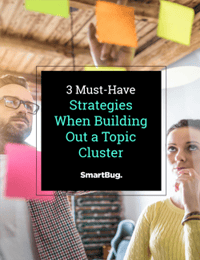
What Content Appeals to Your Audience and Converts Best?
January 28, 2019
By Meryl Kremer
Great marketing content does more than just attract attention—it attracts a specific audience, compels them to engage with your brand, and ultimately drives sales. But how do you know if the content you created is actually attracting and resonating with the right people? What is the secret formula that makes certain pieces of content more effective than others? Below, we’ve outlined how to identify the content that appeals to your audience and be more deliberate in your approach.
Conduct a Content Audit
Whether you’re fairly new to content creation or are a seasoned veteran looking for improvement opportunities, it’s never a bad idea to start with a content audit. Conducting an audit essentially means taking an inventory of all the content resources on your site. Using Google Sheets, Excel, or your preferred charting platform (preferably a cloud-based solution), create a template of the basic information you’ll collect.
If you don’t have a wealth of historical data to work from, start by recording the title, type of content, persona, topic, CTA, and Buyer’s Journey stage targeted by each asset. To start off, you should have at least three pieces of content for each persona (one piece for each stage of their Buyer's Journey). Charting out this information makes it easier to locate gaps in your content strategy to focus your attention on moving forward.
In addition to looking at the persona and Buyer’s Journey stage, check to see that the topics covered align with the needs and challenges of the persona in question. By working to fill conversion gaps and rectify any misalignment that exists, you’ll improve the relevance and resonance of your content for your target audience (a.k.a., the secret formula that makes it appealing). Even if you find that no gaps exist, the audit will help you determine what topics you’ve covered too much or not enough.
If, on the other hand, you find that it’s difficult to map content according to the criteria mentioned above, you’ll need to take a step back in order to progress forward. Focus on editing and tweaking existing assets so that they better align with a specific persona and Buyer’s Journey stage. One of the greatest benefits of conducting an audit in the early stages of launching a blog or website is that it can double as an editorial plan. Simply map-out content you’ll create to fill existing gaps.
Seasoned content marketers should expand their audits to include subtopics and key performance metrics like page views and conversion rates. Connecting key performance metrics to specific personas and funnel stages will help you understand what’s working in specific contexts—and which individual assets are having the greatest impact on revenue. By examining the date each piece was published, you’ll also get a sense for how recently you covered each topic and when updating a high-performing asset might be warranted.
Take a Closer Look at Your Top Performers
As you attempt to distinguish between your top-performing content assets, remember that page views aren’t everything. If a blog post is getting a high volume of visitors but little to no conversions, check to see that the topic is truly relevant to your buyer personas (or if you’re simply attracting unqualified visitors).
If the post is properly targeted, then move on to the CTA. As a rule, the CTA should align with the same criteria as the content with which it appears. It should also provide clear direction as to what your audience should do next. Are readers clicking on the CTA but not making the final conversion leap? Check to see that the gated landing page copy is concise, value-driven, and action-oriented.
If the reason why a popular piece isn’t converting isn’t immediately evident, consider factors such as the title and content format. As prospects search Google for answers to their questions, titles are the primary way they prioritize results. Once they’ve clicked, it’s your job to show them that they’ve made the right choice.
A sensational title may drive traffic to your site, but if you can’t follow through on its implicit promise, visitors won’t stick around for long. Make sure that the expectations set by your blog titles are fulfilled in the article in a straightforward way. If you title your article “5 Secrets for Driving Traffic to Your Site,” but don’t format your content as a numbered list (or worse, don’t stay on topic), then you’ve set your readers up for disappointment and breached their trust.
Once you’ve confirmed that your top performers are truly exceptional in every sense, take the time to examine why they’re outperforming their peers. How are leads finding these assets? Where are they coming from? Is there something unique about the topic or the medium that is driving greater engagement and conversions? Asking “why” will help you apply your success elsewhere.
Identify New Topics
Using your high-performing topics as a starting point, brainstorm ways you might expand on what’s been published or approach it from a different angle. As you do so, refer back to your content audit chart to make sure that you’re not unintentionally repeating ideas that have already been covered. If you’re stuck, you can use HubSpot’s Blog Ideas Generator tool for inspiration.
To help guide your brainstorming process, consider the SEO value of each potential topic. Using HubSpot’s SEO tools, you can identify related keywords and build out topic clusters related to your primary keyword. By focusing your content creation efforts around these topic clusters, you’ll capitalize on the traffic generated by your star asset and ensure that visitors have enough content to keep them engaged once they arrive.
To learn how to use topic clusters to guide your content creation efforts and drive measurable results, download the e-book below.
.jpg?width=120&height=120&name=Photo%20on%206-11-18%20at%209.47%20AM%20(2).jpg)
About the author
Meryl Kremer was formerly a copywriter at SmartBug Media. She has experience championing inbound-savvy content strategies and writing compelling copy for a wide variety of clients, audiences, and industries. Read more articles by Meryl Kremer.







